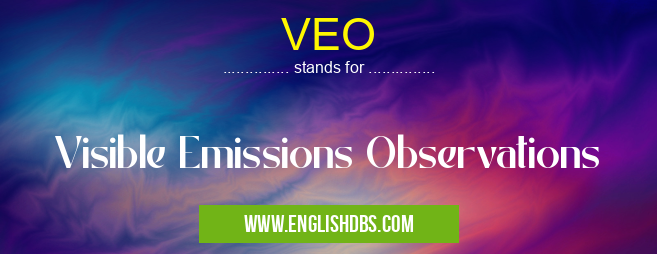What does VEO mean in UNCLASSIFIED
Visible Emissions Observations (VEO) is a method used to assess the amount of pollutants released into the atmosphere from various sources. It involves observing and recording the visible emissions, such as smoke, dust, or fumes, emitted from industrial facilities, power plants, or other sources. VEO is primarily used for regulatory compliance and environmental monitoring purposes.

VEO meaning in Unclassified in Miscellaneous
VEO mostly used in an acronym Unclassified in Category Miscellaneous that means Visible Emissions Observations
Shorthand: VEO,
Full Form: Visible Emissions Observations
For more information of "Visible Emissions Observations", see the section below.
Importance of VEO
VEO plays a crucial role in:
- Monitoring and enforcing environmental regulations: It helps ensure that facilities comply with emission limits and adhere to environmental protection standards.
- Assessing pollution levels: VEO provides data on the emission rates of pollutants, allowing for the identification of emission trends and the effectiveness of pollution control measures.
- Evaluating the performance of pollution control technologies: VEO can assess the efficiency of emission control systems and identify areas for improvement.
- Supporting research and policy development: VEO data contributes to research and policy development efforts aimed at reducing air pollution and improving air quality.
Methodology
VEO typically involves observing and recording visible emissions from a specified vantage point using the naked eye or with the assistance of optical instruments. Observers are trained to identify and quantify the intensity and duration of emissions based on standardized observation protocols. The data collected during VEO can be used to:
- Determine compliance with emission limits: Compare observed emissions to regulatory standards or permit requirements.
- Estimate emission rates: Use emission factors or models to convert observed emissions into quantitative values.
- Identify potential emission sources: Locate specific emission points or identify areas with excessive emissions.
Essential Questions and Answers on Visible Emissions Observations in "MISCELLANEOUS»UNFILED"
What is Visible Emissions Observations (VEO)?
VEO is a method used to assess the presence and opacity of air pollutants emitted from industrial sources, such as smokestacks. It involves trained observers visually inspecting emissions and assigning an opacity level based on the percentage of light obscured.
How is VEO performed?
VEO is typically conducted at a designated observation point, using a standardized procedure and background grid. Observers use binoculars or a spotting scope to view the emissions and determine the opacity level, which ranges from 0% (completely transparent) to 100% (completely opaque).
What is the purpose of VEO?
VEO helps regulators enforce environmental regulations by providing data on the opacity of emissions. This information is used to determine compliance with emission limits, identify potential violations, and assess the effectiveness of pollution control equipment.
Who conducts VEO?
VEO is typically performed by trained and certified observers who have undergone specific training and meet certain qualifications. They must demonstrate proficiency in identifying and assessing opacity levels.
What factors can affect VEO accuracy?
Factors such as lighting conditions, atmospheric conditions (e.g., fog, haze), observer training and experience, and the distance to the emission source can influence the accuracy of VEO.
Final Words: Visible Emissions Observations (VEO) is a valuable tool for environmental monitoring and compliance assessment. By observing and recording visible emissions, VEO provides valuable information on the levels and sources of pollution, enabling stakeholders to take appropriate measures to reduce air pollution and protect public health and the environment.
